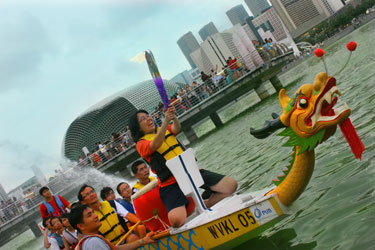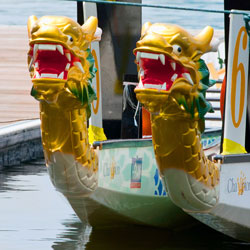HOW TO TAME A DRAGON Did you know that the quiet waters of Singapore's Marina Bay and Kallang River are full of dragons? The mythical creature, a Chinese symbol of power and grace, has found its place in modern life in a form of dragon boating – a sport with more than 2,000 years of history. Like running, horse racing and marksmanship, dragon boat racing is among mankind's oldest organised competitions.
 During the inaugural Youth Olympic Games held in the Lion City, the Olympic Torch
was transported on a dragon boat during one of the legs in SingaporeNowadays, the spectacular sport of dragon boat racing has penetrated the waterways of the world and has recently been identified as the fastest-growing watersport. Popular in over 50 countries and territories around the world, it attracts millions by welcoming people of all fitness and age levels, as well as of broad cultural and occupational backgrounds.
Singapore joined this community in 1976 and, now, along with its national team, there are lots of international crews uniting people from all over the world. For example, the Singapore British Dragon Boat Team counts 16 nationalities among its members, including from Australia, Holland, India, Japan, Korea, Malaysia, Mauritius, New Zealand, the Philippines, Singapore and even Russia!
The Poet's Fate
Once upon a time (more specifically, in the 3rd century B.C.), China was a tangle of many tiny states constantly at war with each other. One of them, the Chinese Kingdom of Chu, was blessed with a model citizen – the eager reformer and poet named Qu Yuan. He was hugely popular with the common folk and Emperor alike, but the envy and fear of reforms didn't let the corrupted courtiers sleep peacefully. They slandered the man of letters and got him banished from the Kingdom. The devastated poet then wandered across the countryside crafting beautiful verses proclaiming his love for the Celestial Empire and concerns about its future. When news of the Chu capital being captured by treacherous neighbours reached Qu Yuan, he embraced a huge stone and drowned himself in a river.
 The Chinese commoners rushed to save him but were too late. The least they could do then was to procure Qu Yuan's body, so they dashed in their boats up and down the river, beating their drums, shouting loudly to scare off the voracious water creatures and throwing rice into the water to feed Qu Yuan's soul. His body was never recovered, but his ghost appeared and explained that all the rice had been taken by the hungry river dragon. So, from then on, to ensure proper "delivery" of the rice to the poet's soul, the Chinese make zongzi (glutinous rice) wrapped in palm or reed leaves and tied with a thread to mislead the dragon. Eating zongzi during the Dragon Boat Festival is a tradition in China, as well as the paddling competitions, which is observed on the fifth day of the fifth lunar month, with the day proclaimed a public holiday.
Men's Job
Even the making of a dragon boat is permeated with superstitions. The boat is constructed in a temple's backyard and no woman is allowed there, as even one look cast by a female will supposedly make the vessel capsize once in the water.
Dragon boats are blessed and "awakened" before a race. The burning of joss paper, making of offerings and chanting of prayers to heavenly gods should scare off evil spirits and make the boats fierce and ready to win the race. The village priest or head of the community dots the eyes of the dragon with a red cloth. These rituals show a community's dedication to its gods, who, in turn, are expected to protect their worshipers from unfriendly spirits of the sea and bless them with prosperity. When the race is over, another set of rites is performed to properly put the dragon boats to "repose" until the next Dragon Boat Festival.
Modern Dragon Boating
Dragon boats may vary in length and crew size. While massive traditional boats may still be seen carrying over 50 people, a modern dragon boat team nowadays usually consists of 20 people. There are 18 paddlers in pairs seated facing the bow, a drummer beating the drum to keep everyone in time and a coxswain who ensures that the long boat carrying the dragon's head and tail stays in its lane and does not collide with others. What makes for a winning crew is not just strength and agility, but perfect timing, thus making dragon boating all about teamwork and cooperation.
Text by Natalia Makarova
Photos Philipp Hayward
|
 +65 6696 7068
+65 6696 7068
 info@meridian103.com
info@meridian103.com
 PDA
PDA
 +65 6696 7068
+65 6696 7068
 info@meridian103.com
info@meridian103.com
 PDA
PDA

Thanks,
Camilo Brooks
camilo brooks, 2012-07-02